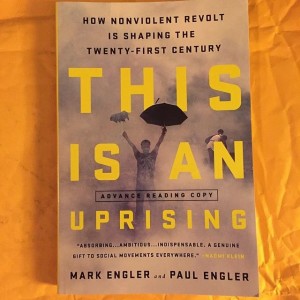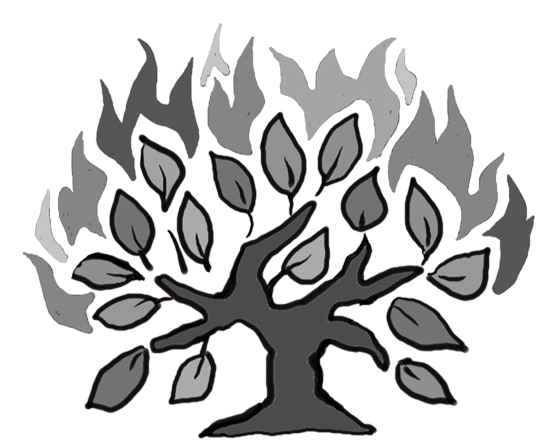This is an Uprising: How Nonviolent Revolt Is Shaping the 21st Century
By Paul Engler
Praise for the Book:
“Absorbing… Ambitious… Indispensable. A genuine gift to social movements everywhere.” –Naomi Klein
“This is a landmark book. [It] puts a name on… a powerful method for making real change fast. And real change fast is in fact what our world requires.” –Bill McKibben, author and co-founder of 350.org
“For all those who dare to dream that truly transformational, even revolutionary change might be possible here in America in our lifetimes (but who wonder what strategies or tactics could possibly achieve a monumental shift in consciousness), this book is for you.” –Michelle Alexander, author of The New Jim Crow
“Mark and Paul Engler have compiled a true masterpiece on the history, logic, ethics, and power of nonviolent action… Sure to inform and inspire for generations to come.” –Erica Chenoweth, co-author of Why Civil Resistance Works
“This book is certain to become a seminal text… [The authors] brilliantly illuminate the debates between advocates of mass mobilization, organization-building, nonviolence, and disruption. Mark and Paul Engler have constructed a new intellectual platform to advance our understanding of these strategic dilemmas.” –Frances Fox Piven, author of Challenging Authority and Poor People’s Movements

I’ll admit it: I am a Gandhi geek. My girlfriend says that when she first saw my bookshelf, she was amazed to see that so many books on Gandhi even existed—and she was slightly worried that anyone driven to collect them all might have some borderline obsessive-compulsive tendencies! And it is true that I was obsessed with Gandhi in college. There was a reason for this. Gandhi did something that changed my life: he allowed me to connect my spiritual life with my political life.
After the WTO protests in Seattle in 1999, I was part of a group working non-stop in what was called the “anti-globalization” movement. We formed an intense community, united by common purpose, and the feelings of love in that group were intoxicating. Gandhi helped me understand how the feelings of closeness within that group were directly related to us all making communal sacrifices—even being willing to be thrown in jail for a cause. Politics, purpose, and the power of personal sacrifice blended in a way that changed me forever, and that had political consequences that reverberated in movements around the world.
Gandhi believed that the kind of historic events I was part of in the anti-globalization movement—and that I later experienced in the immigrant rights movement in 2006 and Occupy in 2011—were not flukes. These mass uprisings were not just events that emerged spontaneously from historical circumstances. Instead, Gandhi believed that historic mobilizations could be produced through human agency. He said that there was a science to it, and he proved himself to be a master experimenter. He showed that, by going through a lot of challenging trial and error, you could hone your skills at engineering these types of mass insurgencies.
In the 1920s, some people in India and abroad thought Gandhi was a magician, owing to his ability to create explosions of social movement activity when and where he wanted. But Gandhi assured them that these explosions—what we call “moments of the whirlwind”—were not magic tricks. He insisted that mass uprisings followed certain laws and principles, like those in the natural sciences. Gandhi saw that while the spirit behind nonviolent resistance had deep roots—in all the major religions, in the prophetic tradition of the Jews, and especially in the beliefs of early Christians—there were only a few people, like Russian novelist Leo Tolstoy, who were explicitly translating it into a theory of collective action. Gandhi wanted to pick up where Tolstoy had left off, to more deeply probe the laws at work, and to give this science to the world.
As a student, I was fascinated by talk of this “science.” And as I began to study “moments of whirlwind,” I realized I was not the only one who was interested in this stuff. Gene Sharp, a relatively unknown academic, had written many volumes of intellectual literature about the subject. Indeed, he has created a whole field of study called “civil resistance” that was devoted to understanding nonviolent uprising. And yet, I felt that few if any of the people around me in my world of student activists and labor organizers had even heard of this field of thought. Even if my friends had picked up a book by Gene Sharp, most hadn’t gotten much out of the experience. A lot of the reading materials available in civil resistance were dry and distant, with no clear relevance to the actual organizing people were doing. But I believed that if you really studied this stuff, you could find answers to some critical questions. The field gave insights into phenomena that left us awestruck when they happened with the global justice movement in 2000, just like when they happened more recently with Occupy and the Arab Spring in 2011: How could we be patiently organizing in our communities for years with only modest results, then all of sudden see thousands—even millions—of people show up in the streets in seemingly spontaneous fashion?
For about six years in the early 2000s, I put that question aside. Instead, I devoted myself to learning the patient arts of community and labor organizing. But I always kept my interest in mass uprising, and in the spring of 2006, I witnessed something remarkable. Almost overnight, the immigrant rights movement exploded. A million people marched through the streets of Los Angeles, a daylong general strike shut down restaurants and local industries, bringing activity at the Port of LA to a crawl. It was amazing to see. By that time, I was in a position to examine things more carefully. I was part of a new team at the Center for the Working Poor that was interested in digging deep into the mysteries behind mass mobilizations like the one we had just experienced. We asked, “How did this happen?” And “how can we make it happen again?”
As fate would have it, we quickly met some guys with profound insights into these very questions. They had started a movement of their own in Serbia, called Otpor. It had successfully created multiple “moments of whirlwinds,” and in 2000 it ended up playing a key role in overthrowing Slobodan Milosevic—a dictator known as the Butcher of the Balkans. The Serbians had also studied Gandhi and Gene Sharp, and they did an amazing job synthesizing and drawing out relevant concepts. Moreover, they had guided 40,000 of their members through weeklong trainings in the principles and laws of this new type of movement-building. Subsequently, I went to many trainings with Ivan Marovic, one of the founders of Otpor, and he became my strategic mentor. At that point, I was inspired to start translating some of these lessons into a US context.
After Occupy Wall street, my life and work took another turn as Carlos Saavedra became interested in partnering with me to find the best ways to bring this organizing model to US activists. Carlos had been a disciple of Marshall Ganz, who devised the system of training tens of thousands of volunteers for the Obama campaign in 2008. For his part, Carlos had trained thousands of undocumented DREAM Act students in the principles of traditional community organizing. He possessed an uncanny talent for grappling with complex ideas, making our thinking more rigorous, and figuring out how to make these ideas relatable. With the support of a new team of talented young organizers that we call the “Momentum Training Institute,” Carlos and I started taking our ideas and making them more simple, clear, and accessible.
Then my brother Mark Engler came into the picture. Since I was little, I always looked up to him. From my perspective as his little brother, he was someone who was literally better at everything than me—he was always the smartest kid in the class, everyone liked him, and he ran really fast. Mark and I had been partners in going to jail in the globalization movement, and we have been thinking and writing together on and off throughout our professional lives. Mark is a much, much better writer than I am. I am dyslexic, and have always been very insecure about my writing. When I worked with Mark on an article, we would closely collaborate on outlines and ideas. Sometimes I would even write a bit, but Mark would mostly rewrite it to meet his much higher standards. I had been pitching to Mark that we needed to take many of these ideas about non-violence and put them in a book. Finally, after more than a year of developing and then pitching our book proposal, Mark and I signed a deal with Nation Books. Our advance did not pay for much, and what we didn’t spend on research went toward supporting Mark’s kids. I would be doing everything as a volunteer, but I was thrilled when we started writing articles related to the book. They were picked up in publications like Waging Nonviolence, Dissent, The Guardian, Salon, The Nation, In These Times, Yes! Magazine, and many others. Mark would sometimes be disappointed if, by our estimates, only 2000 people read our articles; I was psyched that even a few hundred people were reading my stuff!
Anyway, after two years of doing tremendous amounts of research and writing, we finished our book. When we started sending it to prominent academics, thinkers, and activists, we were overwhelmed by the response. It was not just me and my friends at the Center for the Working Poor who thought that we were uncovering rules to a mysterious art with the power to change the world. Now, many people were telling us that they agreed. Professor Steven Zunes wrote to us after reading the manuscript and offered his assessment: “Simply outstanding. The success or failure of future campaigns for peace and justice could depend on how many people read this book. Yes, it’s that good.”
This book has been with me for many years, starting as just a far-off vision. Now that I have shared the story behind it, let me end with a simple appeal: Please read the book. Spread it far and wide. You can preorder it online on Amazon and watch for updates on a GoFundMe site Mark and I will be launching to help support the book tour. And know that, without the Center for the Working Poor and all the support you have given me over the years, it would not exist.



